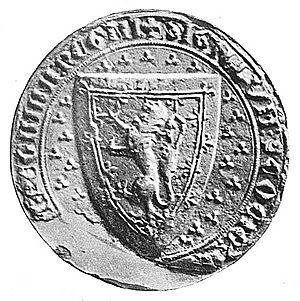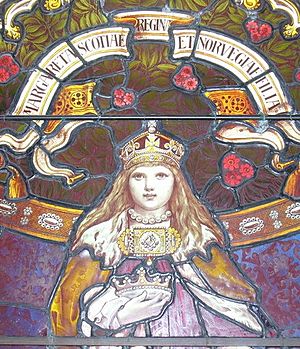Margaret, Maid of Norway facts for kids
Quick facts for kids Margaret |
|
|---|---|
| Queen of Scots | |
| Reign | 1286–1290 |
| Predecessor | Alexander III |
| Successor | John (1292) |
| Born | Between March and 9 April 1283 Tønsberg, Norway |
| Died | Between 26 and 29 September 1290 (aged 7) Orkney Islands, Norway |
| Burial | Christ Church, Bergen |
| House | Sverre (paternal) Dunkeld (maternal) |
| Father | Eric II of Norway |
| Mother | Margaret of Scotland |
Margaret (also known as the Maid of Norway) was a young princess who was meant to become the Queen of Scotland. She was born in March or April 1283 and died in September 1290.
Margaret was the daughter of King Eric II of Norway and Margaret of Scotland. Her grandfather, King Alexander III of Scotland, had no other living grandchildren. This meant Margaret was the next in line to the Scottish throne. When King Alexander III died in 1286, Margaret became the new queen.
Because she was so young, Margaret stayed in Norway. Her father and the Scottish leaders planned for her to marry Edward of Caernarfon, the son of King Edward I of England. Margaret finally set sail for Great Britain in September 1290. Sadly, she died on the Orkney Islands. Her death led to a big fight over who should be the next King of Scotland.
Early Life of Margaret
Margaret, the Maid of Norway, was the only child of King Eric II of Norway. Her mother was Margaret, daughter of King Alexander III of Scotland. Margaret was born in Tønsberg, Norway, between March and April 1283. Her mother died soon after her birth, likely from problems during childbirth.
King Eric was only fifteen years old and did not have much power. So, the young Margaret was cared for by a powerful Norwegian leader, Bishop Narve of Bergen. Her upbringing in Bergen showed that her future marriage was very important for Norway's plans with other countries.
In 1281, a special agreement was made for Eric and Margaret's marriage. It said that if King Alexander III of Scotland had no sons or grandsons, his daughter Margaret and her children would become the next rulers of Scotland. The agreement also mentioned that daughters could inherit the Norwegian throne "if it is the custom." However, Norway's law at the time only allowed sons to inherit the throne. This meant Margaret could not become queen of Norway.
Margaret's uncle, Alexander, who was her mother's brother, died in January 1284. This made Margaret the only living grandchild of King Alexander III. The King wanted to make sure Margaret would be his heir. So, in February, he gathered all the important Scottish nobles. They swore an oath to accept Margaret as his successor if he had no other children.
King Alexander III's first wife, Margaret, had died in 1275. He married a new wife, Yolanda of Dreux, in October 1285. He hoped to have another child. But on March 18, 1286, King Alexander rode in a storm to meet Queen Yolanda. He was found dead the next day with a broken neck.
Becoming Queen of Scotland
After King Alexander's sudden death, Scottish leaders met to decide the future of their country. They promised to protect the throne for the rightful heir. They chose six regents, called the guardians of Scotland, to rule the country. Margaret's claim to the throne was not yet certain. Queen Yolanda, Alexander's new wife, was pregnant. If her child was born alive, that child would be the next ruler.
There was a disagreement in April involving Robert Bruce, 5th Lord of Annandale, and John Balliol. They both wanted to be next in line after Yolanda's child and Margaret. Queen Yolanda's baby was stillborn in November. A few months later, King Eric's advisor arrived in Scotland to claim the kingdom for Margaret. Bruce started a rebellion, but it was quickly stopped. Because the situation was risky, King Eric did not want his three-year-old daughter to leave Norway for Scotland.
In May 1289, King Eric II sent people to King Edward I of England. They talked about Margaret's future. Since Margaret was still in Norway, the Scots could only watch these talks. King Eric owed money to King Edward, and Edward wanted to use this to his advantage.
The Scottish guardians, along with Bruce, finally met with English and Norwegian representatives in October. They signed the Treaty of Salisbury on November 6, 1289. This agreement said that Eric and Margaret, "queen and heir of the kingdom," asked Edward to help Margaret rule. Margaret was to be sent to England or Scotland by November 1, 1290. Once Scotland was safe, Edward would send her to the Scots. Edward could choose her husband, but her father could say no.
Edward wanted Margaret to marry his son, Edward of Caernarfon. The Pope gave special permission for this marriage. The Scottish leaders strongly supported this marriage. It was clear that Margaret's husband would become king. Edward called Margaret "queen" to speed up his son's path to the throne. However, the Scots usually just called her their "lady."
Talks about Margaret's marriage and the future of Scotland and England continued into 1290. The Treaty of Birgham, agreed on July 18, said that Scotland would stay fully independent. It also said that Margaret alone would be crowned queen at Scone.
By late August 1290, Margaret was ready to sail from Bergen to Great Britain. Her father did not go with her. She seemed healthy when she left, but she became sick during the journey. The ship landed in Orkney, a group of islands near Scotland, around September 23. Margaret suffered for about a week, possibly from food poisoning. She died between September 26 and 29, 1290, in the arms of Bishop Narve.
The Scottish leaders, who were waiting at Scone for her crowning, learned of her death in October. Margaret's body was returned to Bergen. King Eric insisted on opening the coffin to make sure it was his daughter. She was then buried in Christ Church.
Margaret's Legacy
Margaret was the last direct descendant of King William the Lion. After her death, thirteen men claimed the Scottish throne. The most famous were Bruce and Balliol. King Eric also tried to claim the Scottish crown, but not very strongly. He died in 1299. In 1301, a German woman pretended to be Margaret, but she was found out and punished.
Historians still discuss whether Margaret should be called a queen and included in the list of Scottish monarchs. She was never crowned. People in Scotland at the time rarely called her queen. They often called her their "lady" or "heir." However, documents from late 1286 suggest that the throne was seen as already taken by Margaret. The Pope also thought Margaret was the Queen of Scotland. Today, most historians call her "queen." They say her reign began on March 19, 1286, the day King Alexander III died.
Family Tree
Margaret's family connections were important for keeping peace between Norway, Scotland, and England. Her position made her central to the fight over who would rule Scotland.
See also
 In Spanish: Margarita I de Escocia para niños
In Spanish: Margarita I de Escocia para niños



